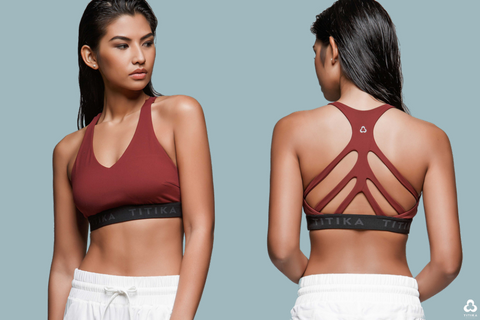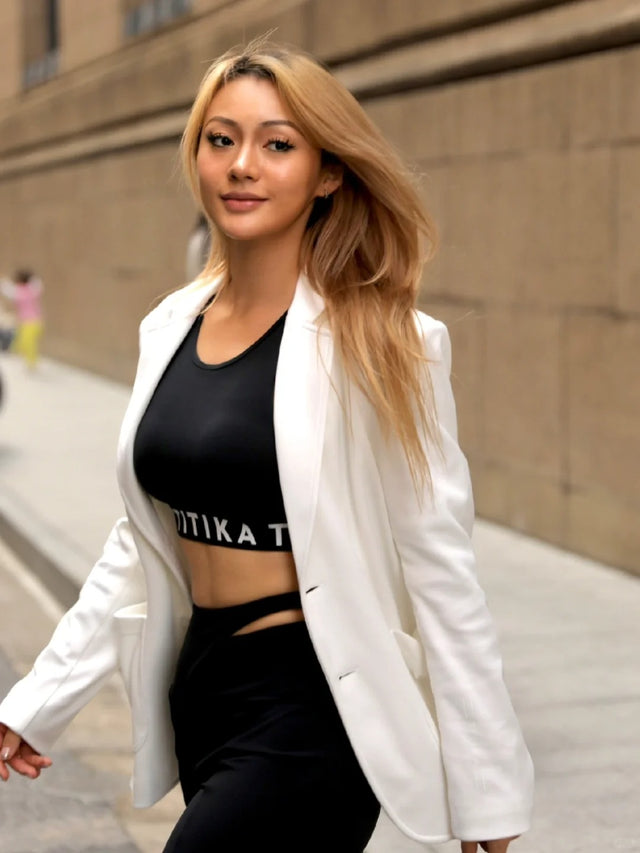10 Things To Know Before Buying a Sports Bra
There is nothing more distracting and uncomfortable than an ill-fitting bra. With every move, your beloved girls are transported from the safety of their cups into a painful joyride consisting of bouncing, pulling, chafing, and discomfort.
 When creating product for Titika, our designers always keep in mind that not every woman is made the same, and in turn, not every breast is created equal. Being an activewear brand that promotes healthy living, we encourage you to keep active, but also encourage to respect the breast and read our 10 things that you need to know before buying a sports bra.
When creating product for Titika, our designers always keep in mind that not every woman is made the same, and in turn, not every breast is created equal. Being an activewear brand that promotes healthy living, we encourage you to keep active, but also encourage to respect the breast and read our 10 things that you need to know before buying a sports bra.
What’s your type?
When purchasing a sports bra, you have a few options to choose from: Compression, Encapsulation, and Compression/Encapsulation.
Compression bras are perfect for low to medium impact activities. Compression bras work to hold the tissue back and limit movement away from the chest.
Encapsulated bras are made with tangible cups that limit cross over movement AKA the uni-boob. Encapsulated bras additionally limit strain, loss of elasticity, and sagging. There is no compression in these bras, making them the best choice for low-impact activities.
Compression/Encapsulation bras combine both technologies and offer support and comfort. These bras provide ultimate support and are best for high-impact activities - Think mountain biking or marathon running.
How do I measure?
Luckily most stores offer complementary sizing, but if you are intrigued and wanting to measure your own busy, follow these tips.
- Stand straight and have someone measure close to your ribcage right below your bust. It is important to pull the tape as snug as possible without pinching. Once placed under the bust, round to the nearest whole number. If the number is odd, add five (5) inches. If the number is odd, add four (4) inches. For example, if you measured thirty-four (34) inches, your band size is thirty-eight (38) inches. If you measured thirty-one (31) inches, your band size is thirty-six (36) inches.
- Take a loose measurement of the fullest part of your chest (at nipple level), and round to the nearest whole number.
- To determine your cup size, subtract your band size from your bust measurement. Example, 37 inches (bust) - 34 inches (band) - 3 inches. This would mean your cup size is a 34C.

*Image and techniques are fromrealsimple.com
Get Strappy
The bra band is responsible for 80% of bust support, meaning that the bra straps were created to support the band, but not carry its weight. As the cup size moves up, the width of the strap should also increase - bra designers who do not take breast size into consideration are typically more focussed on design than practicality. When buying a bra, try this Titika tip: hold the top of one strap and the center of the corresponding cup and pull. The less stretchy the strap, the more motion control.
A note on the band*. When testing size, you should not be able to pull the band more than an inch from your chest. If you reach your arms up overhead and the band creeps up, this is a simple way to know that the bra is definitely too big and it is time to go shopping.
Underwire?
No thank you, no ifs and/or buts. While underwire provides support in traditional bras, underwire for athletics will not provide you ample support for the gym and may cause unnecessary pain.
Style Vs. Comfort
When shopping for an everyday bra, it is typically a shopper's first instinct to put style before comfort. Not many people shop for bras and say “Wow! This bra will offer wonderful support and remove strain from my spine!”, it just does not happen. The best thing about the athletic wear industry is that many brands are jumping on board the sports bra train, thereby creating more options to shop for. With delicate details and incomparable design, our Titika bras will not only provide you with comfort but will additionally act as a comfortable addition to your daily wardrobe. For women with a bigger bust, make sure to always put your body before comfort - a style may not last, but you want to make sure your girls do.
There are no particular differences between pullover vs. clasps, as it comes down to individual style and preference.
Pullover: Pullover sports bras typically cover more of the back than clasp bras, but due to the lack of strap support, pullover sports bras are not the best choice for women with a bigger chest.
Clasps: Sports bras that have clasps usually allow you to tighten the band. As the band is the true source of support, this type of bra is better suited for women with a bigger chest.
Breathability, Moisture Wicking, Oh my!
Moisture wicking fabric refers to the fabric's ability to shift the sweat from the skin for release to the exterior for evaporation. While cotton does have breathability in ready-to-wear garments, it should be avoided when it comes to bras. Cotton has a tendency to soak up the sweat and leave it stuck to the skin, and take it from us, the last thing that you want during your workout is a sweaty chest. When shopping bra fabrics, look for terms like ‘breathable’ and ‘wicking’ as they work to draw moisture away from the body keeping you looking and feeling fresh.
Know your size
It may seem surprising, but your breast will fluctuate in size. The leading cause for sports bra discomfort is from incorrect sizing. Chances are that your bust is not the exact same size that it was a year ago. To combat any error when bra shopping, it is best practice to get remeasured every year to make sure you are shopping your true size.
Time to shop?
Who doesn't love a new sports bra? Actually, there is evidence to prove that refreshing your sports bra selection on the regular is beneficial. A sports bra deals with a lot of attack and wear, and with so much movement and washing, the fibers of the fabric can quickly degrade thereby shortening the lifespan. The lifespan of your sports bra should be roughly nine months of regular wear - This is typically dependent on the style and design.
How do I care for my bras?
To extend the life of your sports bras and to keep them in optimal condition, it is best to hand wash the garment and hang or lay flat to dry. While not everyone may have the time to wash sports bras by hand, you can alternatively wash on cold with no bleach or fabric softener. An important tip to remember is to not dry your bras in the dryer. Heat breaks down spandex depleting the durability and functionality of your bras.
By: Kyle Mack



